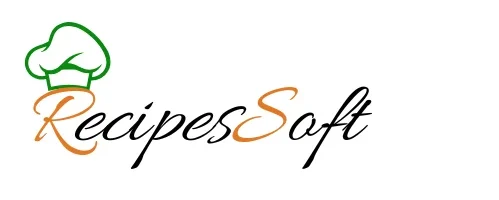Sheet Pan Kielbasa Dinner
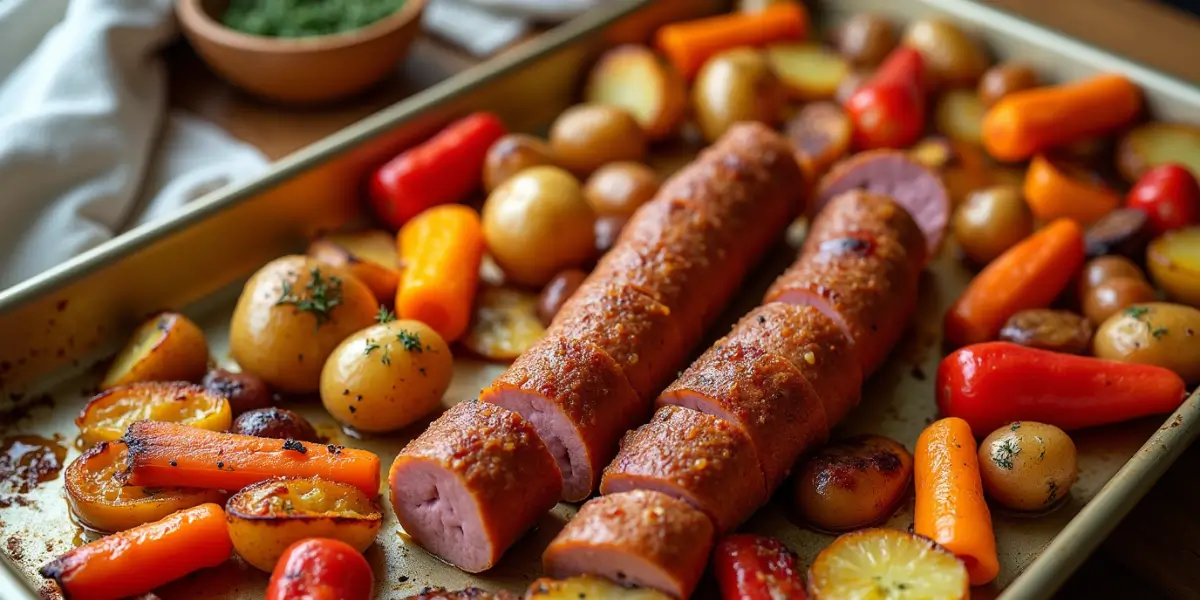
Picture this: It’s 6 PM on a Tuesday, you’re exhausted from work, and the last thing you want to do is spend an hour cooking and cleaning multiple pots and pans. Sound familiar? You’re not alone. Millions of busy families face this dinner dilemma every single night. That’s exactly why I fell in love with sheet pan kielbasa dinner – a one-pan wonder that transformed my weeknight cooking routine forever.
The first time I tried making a sheet pan kielbasa dinner, I was skeptical. Could something so simple really be satisfying and delicious? After one bite of perfectly roasted kielbasa paired with caramelized vegetables, I was completely convinced. This isn’t just another quick dinner hack – it’s a game-changing approach to family meals that delivers maximum flavor with minimal effort.
Why Sheet Pan Kielbasa Dinner Is the Perfect Weeknight Solution
The Science Behind One-Pan Success
Sheet pan cooking isn’t just convenient – it’s scientifically brilliant. When you roast kielbasa and vegetables together on a single pan, several magical things happen simultaneously. The high heat of your oven creates the Maillard reaction, browning both the sausage and vegetables to develop deep, complex flavors that simply can’t be achieved through other cooking methods.
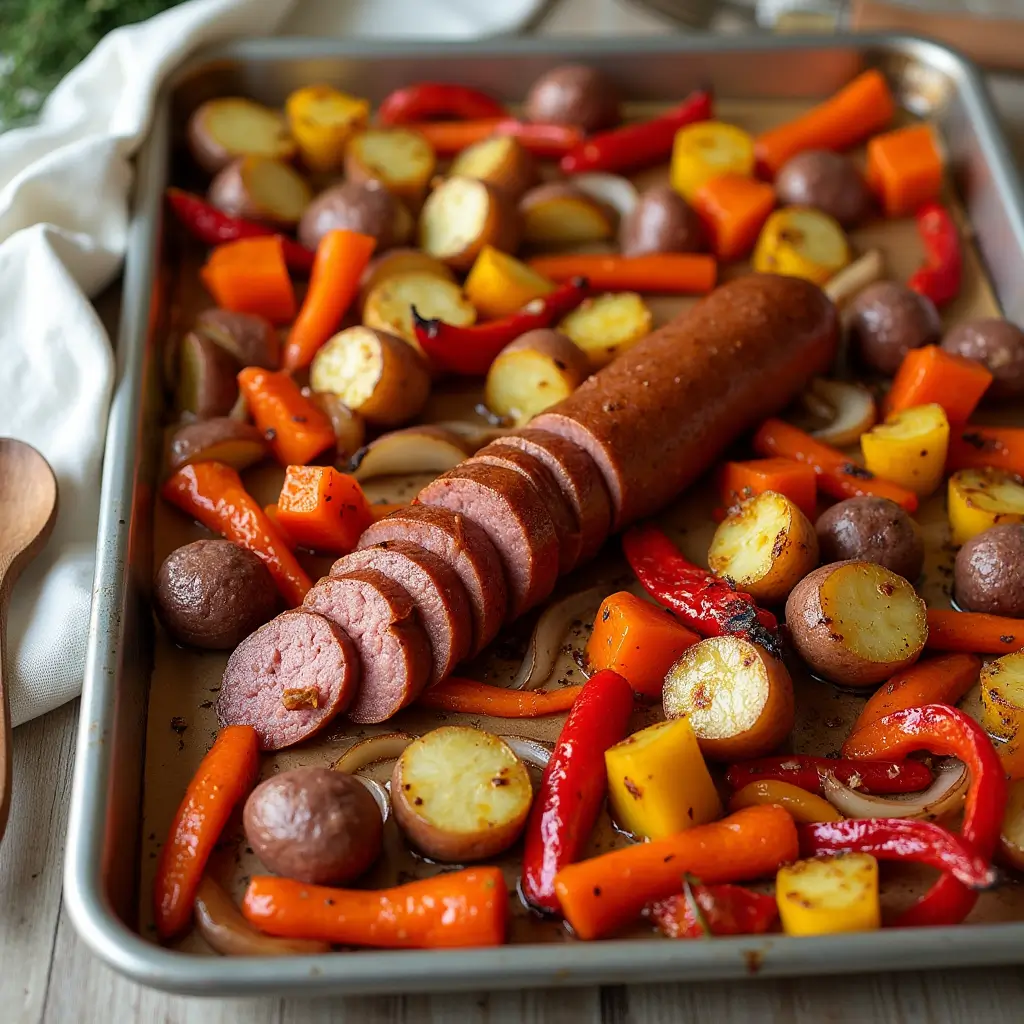
The natural fats from the kielbasa render out during cooking, basting the surrounding vegetables and infusing them with smoky, savory goodness. This means every bite delivers layers of flavor that taste like you spent hours in the kitchen, when in reality, your active cooking time was just minutes.
Time-Saving Benefits That Actually Matter
Let’s talk real numbers here. A traditional kielbasa dinner might require you to brown the sausage in one pan, steam or sauté vegetables in another, and possibly prepare a starch in a third pot. That’s three different cooking vessels, multiple cooking times to coordinate, and a sink full of dishes afterward.
With sheet pan kielbasa dinner, you’re looking at approximately 5 minutes of prep time and 25-30 minutes of hands-off cooking. While your dinner roasts, you can help with homework, catch up on emails, or simply relax. The cleanup? One pan, one cutting board, and one knife. It’s efficiency that actually works in real life.
Nutritional Advantages You’ll Love
Beyond convenience, sheet pan kielbasa dinner offers impressive nutritional benefits. Kielbasa provides high-quality protein – typically 14-16 grams per serving – along with essential B vitamins, particularly B12, which supports energy metabolism and nervous system function.
When you pair kielbasa with a variety of colorful vegetables, you’re creating a well-balanced meal that covers multiple food groups. Root vegetables like potatoes and carrots provide complex carbohydrates and fiber, while bell peppers and onions contribute vitamin C and antioxidants. The roasting process actually concentrates many nutrients, making them more bioavailable for your body to absorb.
Essential Ingredients and Equipment for Sheet Pan Kielbasa Success
Choosing the Right Kielbasa for Maximum Flavor
Not all kielbasa is created equal, and your choice can make or break your sheet pan dinner. Traditional Polish kielbasa, also called “kielbasa polska,” offers the most authentic flavor with its blend of pork, beef, and traditional seasonings like garlic and marjoram. Look for brands that use natural casings – they’ll have better texture and won’t split as easily during roasting.
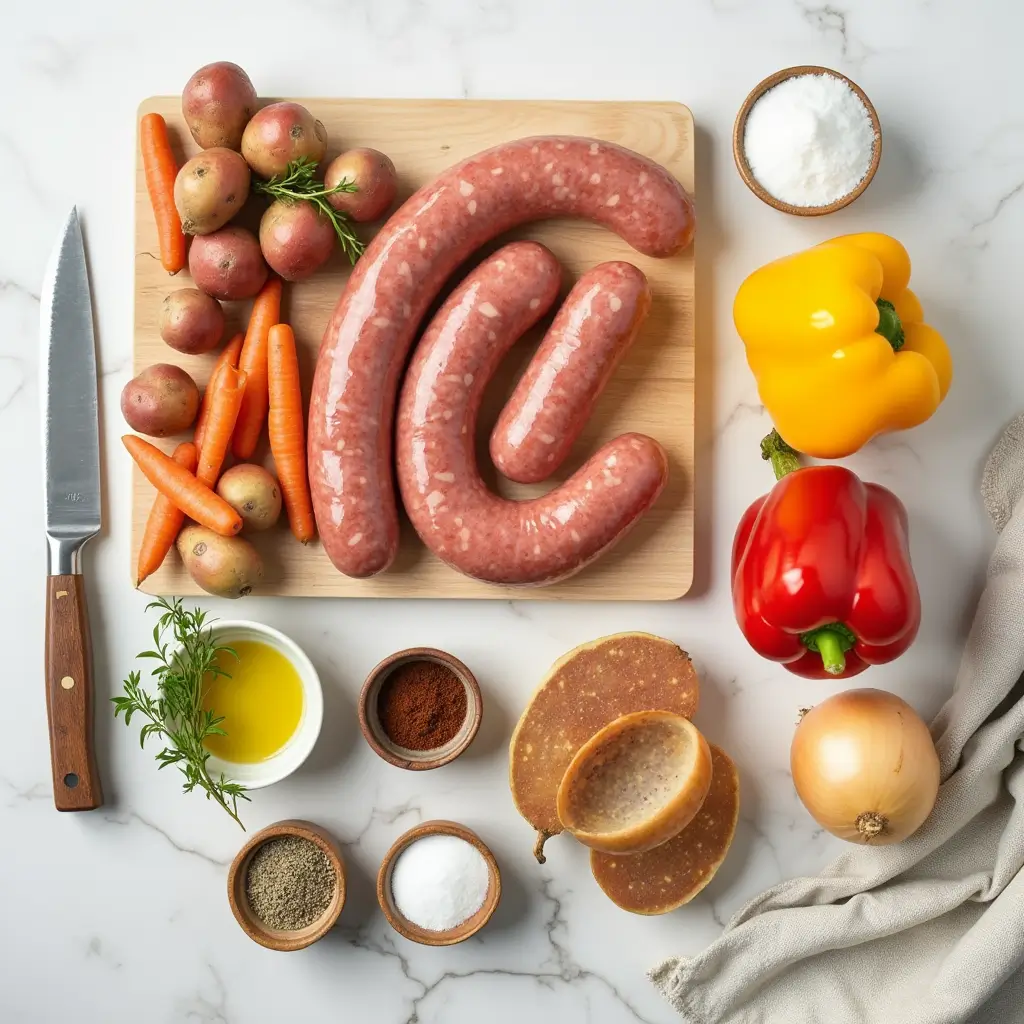
Turkey kielbasa provides a leaner alternative without sacrificing much flavor, making it perfect for health-conscious families. If you’re feeding picky eaters, mild kielbasa varieties work wonderfully, while those who love bold flavors should seek out spicy or garlic varieties.
For the best results, avoid pre-cooked cocktail-style sausages. Full-sized kielbasa (typically 12-16 inches long) gives you more control over portion sizes and tends to have superior flavor and texture.
Vegetable Selection That Guarantees Perfect Results
The key to outstanding sheet pan kielbasa dinner lies in choosing vegetables with similar cooking times. Root vegetables like potatoes, carrots, and parsnips need the full cooking time to become tender and caramelized. Cut these into 1-inch pieces for even cooking.
Medium-cooking vegetables such as bell peppers, zucchini, and onions should be cut slightly larger (1.5-inch pieces) since they’ll cook faster than root vegetables. If you want to include quick-cooking vegetables like cherry tomatoes or snap peas, add them during the last 10 minutes of cooking to prevent overcooking.
Here’s a pro tip that changed everything for me: toss harder vegetables with oil and seasonings first, then add them to the pan. Give them a 10-minute head start before adding your kielbasa and medium-cooking vegetables. This ensures everything finishes at the same time.
Must-Have Equipment and Tools
While sheet pan cooking seems straightforward, having the right equipment makes a significant difference in your results. A heavy-duty rimmed baking sheet (also called a half-sheet pan) is essential – typically 18×13 inches. Lightweight pans can warp under high heat, leading to uneven cooking.
Parchment paper or a silicone baking mat prevents sticking and makes cleanup even easier. Avoid aluminum foil directly against the food, as it can react with acidic ingredients and affect flavor.
A large mixing bowl allows you to properly toss vegetables with oil and seasonings before arranging them on the pan. Don’t try to season directly on the pan – you won’t achieve even distribution, and your vegetables will cook unevenly.
Step-by-Step Guide to Perfect Sheet Pan Kielbasa Dinner
Preparation Techniques That Make the Difference
Proper preparation is where most home cooks either succeed brilliantly or miss the mark entirely. Start by preheating your oven to 425°F (220°C) – this high temperature is crucial for achieving the caramelization that makes sheet pan dinners so delicious.
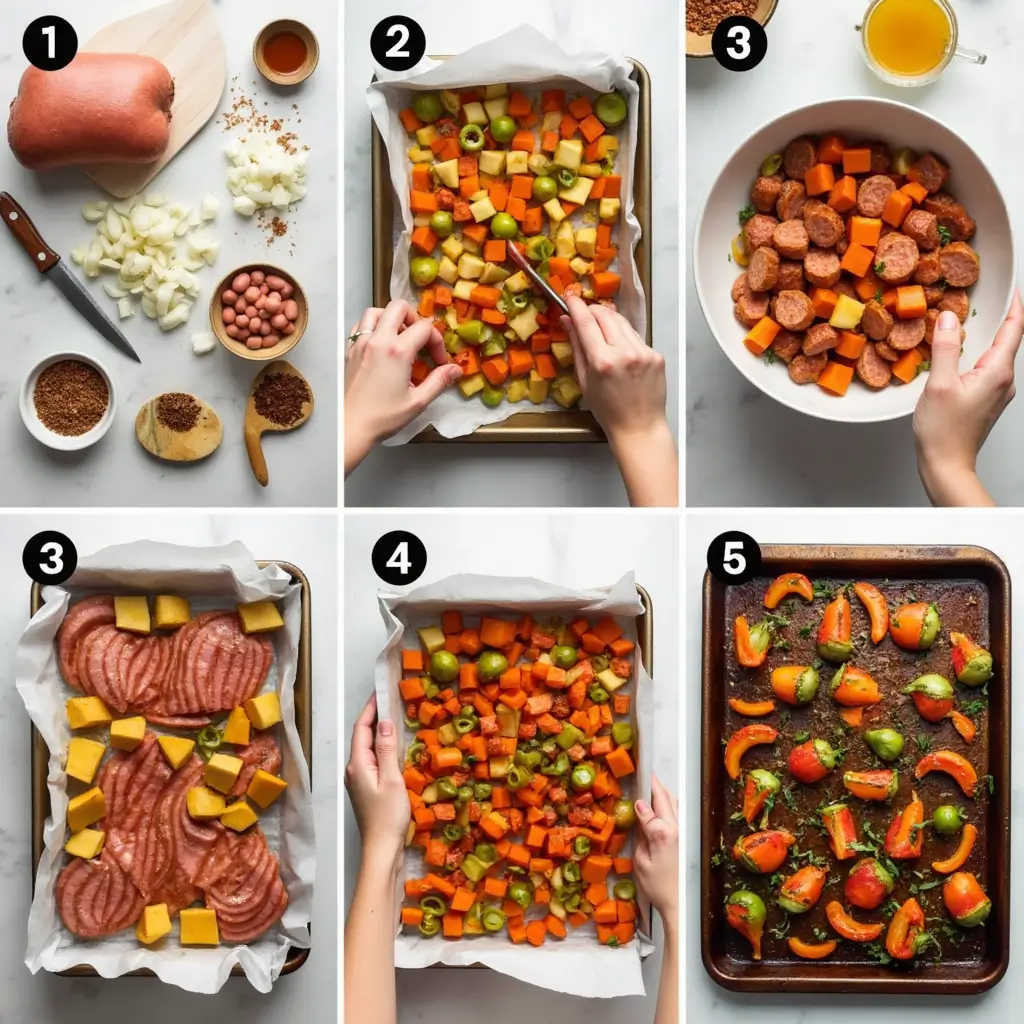
While your oven preheats, prepare your vegetables by washing, peeling (where necessary), and cutting them into uniform pieces. Consistent sizing isn’t just about appearance – it ensures everything cooks evenly. Pat vegetables dry with paper towels, especially if you’ve washed them, as excess moisture will steam rather than roast your ingredients.
Score your kielbasa by making diagonal cuts about 1/4 inch deep and 1 inch apart along the length. This isn’t just decorative – it allows fat to render more effectively and prevents the casing from bursting. If your kielbasa is particularly long, cut it into 4-6 inch sections for easier serving and more even cooking.
Seasoning Strategies for Maximum Impact
The difference between good and extraordinary sheet pan kielbasa dinner often comes down to seasoning. Create a base seasoning blend using 2 tablespoons olive oil, 1 teaspoon each of garlic powder, onion powder, and smoked paprika, plus 1/2 teaspoon each of dried thyme and black pepper.
Toss your harder vegetables (potatoes, carrots) with half this mixture first. The oil helps conduct heat and promotes browning, while the seasonings penetrate the vegetables during cooking. Reserve the remaining seasoning mixture for your kielbasa and quicker-cooking vegetables.
Don’t forget salt, but add it strategically. Kielbasa is already well-seasoned and salty, so taste a small piece first. You’ll usually need just a light sprinkle on the vegetables – about 1/2 teaspoon for a full sheet pan.
Cooking Timeline and Temperature Control
Here’s the exact timeline I use for perfect results every time:
Minutes 0-5: Oven preheating, vegetable prep Minutes 5-10: Toss root vegetables with oil and seasonings, arrange on pan Minutes 10-20: Root vegetables roast alone Minutes 20-25: Add kielbasa and medium-cooking vegetables Minutes 25-35: Everything roasts together Minutes 35-40: Optional final browning at 450°F
This staggered approach ensures every component reaches its ideal doneness simultaneously. Root vegetables become tender and caramelized, kielbasa develops a beautiful brown exterior while heating through, and quicker-cooking vegetables retain their texture and bright color.
Monitor your sheet pan dinner during the last 10 minutes. If vegetables are browning too quickly, reduce temperature to 400°F. If you want more caramelization, increase to 450°F for the final 5 minutes.
Recipe Variations and Customization Ideas
International Flavor Profiles to Explore
While traditional sheet pan kielbasa dinner is delicious, exploring international flavor combinations can keep this meal exciting week after week. For a Mediterranean twist, swap your usual seasonings for oregano, basil, and a splash of balsamic vinegar. Add cherry tomatoes, zucchini, and red onions for vegetables that complement these flavors beautifully.
German-inspired variations work naturally with kielbasa’s Polish heritage. Try seasoning with caraway seeds, dill, and a touch of mustard powder. Pair with sauerkraut added in the last 10 minutes of cooking, along with potatoes and carrots. The result tastes like comfort food from a European bistro.
For those who enjoy Mexican flavors, create a sheet pan kielbasa dinner with cumin, chili powder, and smoked paprika. Use bell peppers, onions, and small potatoes, and serve with warm tortillas and fresh cilantro. The smoky kielbasa pairs surprisingly well with these bold, warm spices.
Dietary Modifications That Actually Work
Adapting sheet pan kielbasa dinner for different dietary needs doesn’t require completely reinventing the dish. For lower-carb versions, replace potatoes with additional bell peppers, zucchini, and cauliflower florets. These vegetables roast beautifully and provide satisfying bulk without the starch.
Gluten-free families can enjoy this meal without any modifications – just verify that your chosen kielbasa brand doesn’t contain wheat-based fillers (most don’t, but it’s worth checking). The entire cooking method and ingredient list naturally aligns with gluten-free requirements.
For those watching sodium intake, look for lower-sodium kielbasa varieties and reduce or eliminate added salt in your vegetable seasoning. The roasting process concentrates natural flavors enough that you won’t miss the extra sodium.
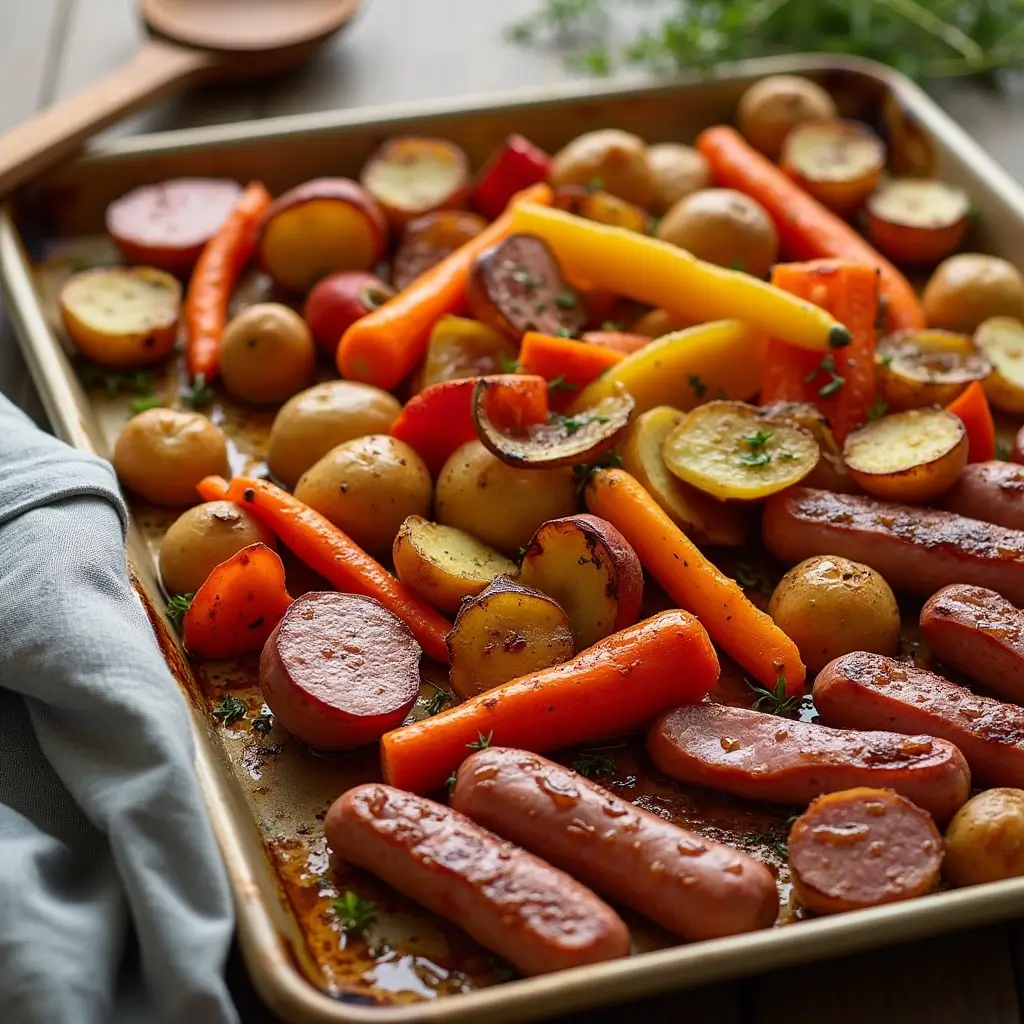
Seasonal Ingredient Swaps
Adapting your sheet pan kielbasa dinner to seasonal vegetables keeps the meal fresh and cost-effective throughout the year. Spring variations might include asparagus, new potatoes, and snap peas – add the asparagus and snap peas during the last 12 minutes of cooking to prevent overcooking.
Summer sheet pan dinners shine with zucchini, yellow squash, cherry tomatoes, and bell peppers. These vegetables contain more water than winter varieties, so pat them extra dry and consider increasing your oven temperature to 450°F to compensate for the additional moisture.
Fall and winter are perfect for heartier vegetables like Brussels sprouts, sweet potatoes, parsnips, and butternut squash. These robust vegetables can handle the full cooking time and develop incredible caramelization that pairs beautifully with kielbasa’s smoky flavor.
Essential Recipe Information
Complete Ingredient List and Measurements
| Ingredient | Amount | Notes |
|---|---|---|
| Kielbasa | 1 lb (16 oz) | Polish or turkey variety |
| Baby potatoes | 1.5 lbs | Cut in half if large |
| Carrots | 1 lb | Cut into 1-inch pieces |
| Bell peppers | 2 large | Any color, 1.5-inch pieces |
| Yellow onion | 1 large | Cut into wedges |
| Olive oil | 3 tablespoons | Extra virgin preferred |
| Garlic powder | 1 teaspoon | |
| Onion powder | 1 teaspoon | |
| Smoked paprika | 1 teaspoon | |
| Dried thyme | 1/2 teaspoon | |
| Black pepper | 1/2 teaspoon | Freshly ground |
| Salt | 1/2 teaspoon | Adjust to taste |
Nutritional Information Per Serving
| Nutrient | Amount | % Daily Value |
|---|---|---|
| Calories | 385 | 19% |
| Protein | 18g | 36% |
| Carbohydrates | 28g | 9% |
| Dietary Fiber | 4g | 16% |
| Total Fat | 22g | 34% |
| Saturated Fat | 7g | 35% |
| Sodium | 680mg | 28% |
| Vitamin C | 95mg | 158% |
| Potassium | 890mg | 25% |
*Based on 6 servings per recipe

Storage and Reheating Guidelines
| Storage Method | Duration | Best Practices |
|---|---|---|
| Refrigerator | 3-4 days | Store in airtight container |
| Freezer | 2-3 months | Portion into meal-sized containers |
| Reheating (Oven) | 15 minutes at 350°F | Cover with foil to prevent drying |
| Reheating (Microwave) | 2-3 minutes | Heat in 30-second intervals |
Frequently Asked Questions About Sheet Pan Kielbasa Dinner
Q: How long does sheet pan kielbasa dinner take from start to finish?
Sheet pan kielbasa dinner typically requires 35-40 minutes total cooking time, with only 5-10 minutes of active preparation. The beauty of this meal lies in its hands-off cooking approach – once everything goes in the oven, you’re free to handle other tasks while dinner cooks itself. For busy weeknights, you can even prep your vegetables in the morning and simply toss everything together when you’re ready to cook.
Q: Can I make sheet pan kielbasa dinner ahead of time?
Absolutely! You can prepare sheet pan kielbasa dinner up to 24 hours in advance. Chop your vegetables and store them in the refrigerator, then simply toss with seasonings and arrange on your pan when ready to cook. You can also fully cook the meal and reheat portions throughout the week – it reheats beautifully in the oven at 350°F for 10-15 minutes. For meal prep enthusiasts, this recipe doubles easily and provides 4-6 meals for the week.
Q: What vegetables work best in sheet pan kielbasa dinner?
The most successful vegetables for sheet pan kielbasa dinner are those that roast well and complement the smoky flavor of the sausage. Root vegetables like potatoes, carrots, and parsnips are excellent choices because they become caramelized and tender during the cooking process. Bell peppers, onions, and zucchini add color and different textures. Avoid delicate vegetables like leafy greens or mushrooms, as they’ll overcook and become soggy in the high-heat environment.
Q: How do I prevent my vegetables from becoming soggy in sheet pan kielbasa dinner?
Preventing soggy vegetables in your sheet pan kielbasa dinner comes down to three key factors: proper preparation, adequate spacing, and correct oven temperature. Always pat vegetables dry after washing, and don’t overcrowd your pan – vegetables need space for air to circulate. Use a high temperature (425°F minimum) to promote browning rather than steaming. If your vegetables release a lot of moisture during cooking, briefly remove the pan and drain any excess liquid before returning to the oven.
Transform your weeknight dinner routine today with this foolproof sheet pan kielbasa dinner recipe. The combination of minimal prep work, maximum flavor, and easy cleanup makes this meal a true winner for busy families. Give it a try this week, and don’t forget to experiment with your favorite seasonal vegetables – I’d love to hear about your creative variations in the comments below!
Are You Try This Recipe ?
There are no reviews yet. Be the first one to write one.
